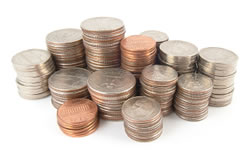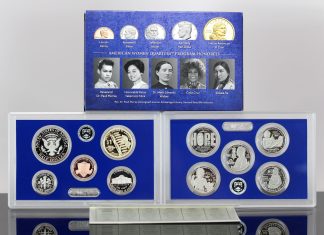 The recent hearing on "The State of U.S. Coins and Currency" by the House Subcommittee on Domestic Monetary Policy and Technology yielded another interesting sub-topic aside from the increased chance for 2010 Silver Eagle proofs previously mentioned on CoinNews.
The recent hearing on "The State of U.S. Coins and Currency" by the House Subcommittee on Domestic Monetary Policy and Technology yielded another interesting sub-topic aside from the increased chance for 2010 Silver Eagle proofs previously mentioned on CoinNews.
In fact, this topic proved to be a bit more contentious than the eagles as it invoked a miniature power struggle between the executive branch of the United States and Congress. At the heart of the matter is the makeup of American circulating coinage — its composition.
For sometime, Lincoln penny and Jefferson nickel production costs have been higher than their corresponding 1c and 5c face values. In Fiscal Year 2009, the US Mint estimated the cent cost $0.0162 to produce while the nickel ran $0.0603 a piece.
Cost of Producing Circulating Coins – FY 09
| Lincoln Cent | Jefferson Nickel | Roosevelt Dime | Washington Quarter | $1 Coins |
| $0.0162 | $0.603 | $0.0565 | $0.1131 | $0.340 |
The largest factor in this imbalance is attributed to the metal composition of each coin and the cost of attaining those metals.
The cent is struck from a composition of 97.5% Zinc and 2.5% Copper. The nickel is created from 75% copper and 25% nickel. In recent years, these metals prices have spiraled higher and higher creating the interesting problem of the government losing money in producing America’s smallest coins.
"The current situation is unprecedented. Compared to their face values, never before in our Nation’s history has the Government spent as much money to mint and issue coins and, with regard to the one-cent and 5-cent coins, never before has the Nation spent more to mint and issue a circulating coin than its legal tender value," U.S. Mint Director Ed Moy testified. "This problem is needlessly wasting hundreds of millions of dollars."
For years now, the U.S. Mint (through the Treasury Department and ultimately the White House) has been attempting to solve the problem. Their solution, which has been introduced several times, is have Congress extend the authority to the Treasury Secretary to determine the composition of circulating coinage. However, Congress has been reluctant to relinquish this power which was given to it in Article 1, Section 8 of the United States Constitution.
In fact, even before the panel called to testify to the subcommittee was allowed to speak, a few of the committees members stated their position of opposition.
"I oppose the Mint’s current efforts to gain greater power in determining the composition of circulating coinage," stated Representative Ron Paul during the subcommittee hearing. "It is unconstitutional to delegate the determination of the metal content of our coinage to the Secretary of the Treasury."
Paul then addressed the fact that Congress has already given the Treasury Department a portion of this power (as it relates to the dollar coin).
"It is a shame that Congress has already unconstitutionally delegated its coinage authority to the Treasury Department," continued Representative Paul, "but that is no reason to further delegate our power and essentially abdicate Congressional oversight."
Rep. Paul’s position on the matter has been such for several years, going back to at least 2008 when he voiced similar statements during testimony over the Coin Modernization and Taxpayer Savings Act of 2008.
 That legislation eventually passed in the House and would have changed the metallic composition of the penny and 5-cent nickel to a less expensive copper-colored steel. The Senate never took the measure up.
That legislation eventually passed in the House and would have changed the metallic composition of the penny and 5-cent nickel to a less expensive copper-colored steel. The Senate never took the measure up.
In support of the administration’s position that the Treasury Department be given the power to change all coin compositions as it deemed appropriate, Mint Director Ed Moy’s testimony focused on the fact that such a decision would save taxpayer’s money.
"The Administration proposal expands the Secretary of the Treasury’s authority to determine the weight and composition of the $1 coin to all circulating coinage." stated Moy.
"This approach will fairly and efficiently manage the highly technical evaluations of alternative materials using a transparent, open, deliberative, and market-driven process that will ensure the interests of all those parties that may be affected — be the vending machine operators, coin handling equipment manufacturers, banks, armored carriers, transit officials, or members of the general public — will be considered and appropriately served.
Moreover, the proposal is a durable solution that would ultimately result in significant taxpayer savings by providing to the Secretary of the Treasury the flexibility to respond quickly to changing market conditions."
Moy added: "The Department of the Treasury has decades of proven success in determining the materials for our highest and lowest coin denominations, and now we are proposing to save millions of dollars per year — over one billion dollars in the next 10 years — by determining the materials for the other coin denominations."
Some in the private sector have their opinion on the matter as well. Craig A. Hesch, Chairman, National Automatic Merchandising Association, who was a part of a second panel presenting testimony to the subcommittee, warned that any changes to the composition of circulating coinage could cost the industry millions of dollars. This would mostly be attributed to vending machines that may need reprogramming or refitted to recognize the validity of the new coinage. If such a change were allowed, he recommended that it be limited to the "low value coins such as a penny or nickel."
It would seem the supportable route — at least from the buzz around the hearing — would have the Mint research, test and take on the expense of creating new coin content specifications, and then forward their work on in the form of recommendations to members of Congress who might then introduce legislation calling for new compositions.






If it saves taxpayer $$$, let’s have steel pennies & nickels. Vending machines were adjusted for the new currency back in the 1990s, so they can be adjusted for the new coins. This may even create new jobs for a few months. The steel industry can also use the boost if the mint has steel pennies & nickels in 2011.
This is definitely a Congressional matter and not one for the Treasury. It’s one of those rare, impossible-to-contest facts. It’s right there in the Constitution. I understand changing the composition of the cent and nickel but the idea of messing with the compositions of the dime and higher baffles me. They are already produced far below face-value. Why is there even an inkling of thought in that matter? Am I the only one who’s proud of the fact that the United States has had a pretty good track record with coin compositions? The fact that decades worth of coins are… Read more »
get rid of pennies altogether, round to the nearest cent. Prices almost always end with 99 cents. Rounding a penny will not have an effect. I noticed some businesses like restaurants do this and set prices so that with tax, it comes out to be even dollar or 50 cents.
I’m always amazed that these debates focus on the (admittedly not-inconsiderable) losses due to negative seigniorage for cents and nickels but NEVER EVER bring up the enormous expense associated with continued production of $1 bills. The US is pretty much alone among major nations in keeping its lowest-denomination bill, despite estimates of direct costs upwards of $750 million a year, similar indirect costs, and an increasing problem with pollution resulting from disposal of used bills. Somehow hundreds of millions of Europeans, Aussies, Canadians, etc can use $1 / €1 / £1 coins (and even 2’s) without problems, but as more… Read more »
Of course rationally they should get rid of the dollar bill and the penny but less rationally and more realistically they should make steel pennies and not even change the colour. Am I the only one that thinks those pennies in the picture look much much better?
[…] topic was not discussed to the same degree as changing coin compositions or producing proof American Silver Eagles at the expense of the bullion versions. However, it tied […]
A dollar coin is a stupid option! This info comes from a country who uses one – Canada! Back when Canada switched over – they thought it was a good idea. The problem is that the banks got stuck with tons of dollar coins b/c the cost (metal is more a lot heavier) to ship them out to get larger bills.
Also – as is typical from their example, when a dollar became pocket change – everything inflated in price. Hence they needed the Twonie (two dollar coin). Pockets are heavy with change now and complaints re heard!
[…] coin composition debate returned in July when Director Moy noted that in Fiscal 2009 it took 1.62 cents to produce the […]
My husband and I are trying to find information on three pennies. “1944” steel wheat penny, it passes the magnet test. “1981” steel penny, yes it does exist and looks like a shinny new dime. It also passes the magnet test. Our latest addition is a “2010” copper penny with a shield on the reverse side and a “one cent” banner streaming accross the bottom of the shield. We have been storing them in a bank vault and would prefer to know if we are just waisting our money with our maximum security plan of if we are justified and… Read more »
Babe Loucks – did you do a quick internet search (e.g. http://www.usmint.gov) before locking your new shield penny in a vault? It’s the new design that replaces the old Lincoln Memorial. There are -billions- of them just now starting to drift into circulation so they’ll be about as rare as beach sand. However I’m not at all sure about the other two coins. There are a few known 1944 steel cents but AFAIK, ALL 1981 cents were struck in bronze, and no other 20th-century US coins except 1943 cents were struck in a metal that sticks to a magnet. It’s… Read more »